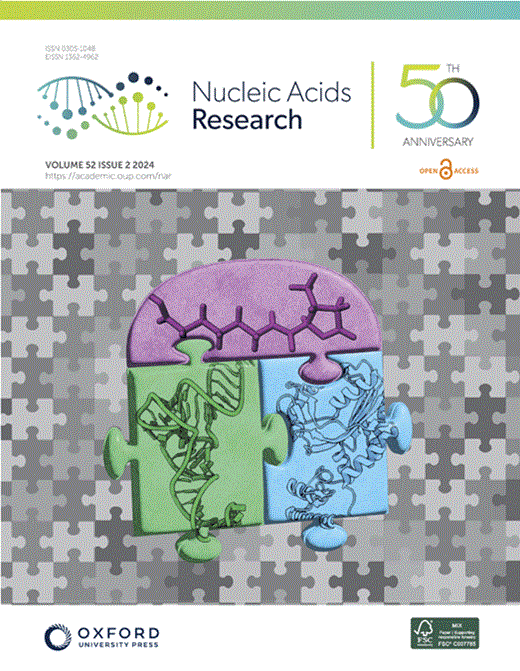Unlocking precision in aptamer engineering: a case study of the thrombin binding aptamer illustrates why modification size, quantity, and position matter
IF 16.6
2区 生物学
Q1 BIOCHEMISTRY & MOLECULAR BIOLOGY
引用次数: 0
Abstract
The thrombin binding aptamer (TBA) is a prototypical platform used to understand the impact of chemically-modified nucleotides on aptamer stability and target affinity. To provide structural insight into the experimentally-observed effects of modification size, location, and number on aptamer performance, long time-scale molecular dynamics (MD) simulations were performed on multiple binding orientations of TBA–thrombin complexes that contain a large, flexible tryptophan thymine derivative (T-W) or a truncated analogue (T-K). Depending on modification position, T-W alters aptamer–target binding orientations, fine-tunes aptamer–target interactions, strengthens networks of nucleic acid–protein contacts, and/or induces target conformational changes to enhance binding. The proximity and 5′-to-3′ directionality of nucleic acid structural motifs also play integral roles in the behavior of the modifications. Modification size can differentially influence target binding by promoting more than one aptamer–target binding pose. Multiple modifications can synergistically strengthen aptamer–target binding by generating novel nucleic acid–protein structural motifs that are unobtainable for single modifications. By studying a diverse set of modified aptamers, our work uncovers design principles that must be considered in the future development of aptamers containing chemically-modified nucleotides for applications in medicine and biotechnology, highlighting the value of computational studies in nucleic acids research.解锁适配体工程的精确性:凝血酶结合适配体的案例研究说明了为什么修饰的大小、数量和位置很重要
凝血酶结合适配体(TBA)是一个典型的平台,用于了解化学修饰核苷酸对适配体稳定性和目标亲和力的影响。为了从结构上深入了解实验观察到的修饰大小、位置和数量对适配体性能的影响,我们对含有大型柔性色氨酸胸腺嘧啶衍生物(T-W)或截短类似物(T-K)的 TBA-凝血酶复合物的多个结合方向进行了长时间尺度分子动力学(MD)模拟。根据修饰位置的不同,T-W 可改变适配体与目标的结合方向,微调适配体与目标的相互作用,加强核酸-蛋白质接触网络,和/或诱导目标构象变化以增强结合。核酸结构基团的邻近性和 5′-3′方向性也对修饰的行为起着不可或缺的作用。修饰的大小可以通过促进一种以上的适配体-靶标结合姿态对靶标结合产生不同的影响。多重修饰可以产生单一修饰无法实现的新型核酸-蛋白质结构基团,从而协同加强适配体与目标的结合。通过研究一系列不同的修饰适配体,我们的工作揭示了在未来开发含有化学修饰核苷酸的适配体应用于医学和生物技术时必须考虑的设计原则,突出了计算研究在核酸研究中的价值。
本文章由计算机程序翻译,如有差异,请以英文原文为准。
求助全文
约1分钟内获得全文
求助全文
来源期刊

Nucleic Acids Research
生物-生化与分子生物学
CiteScore
27.10
自引率
4.70%
发文量
1057
审稿时长
2 months
期刊介绍:
Nucleic Acids Research (NAR) is a scientific journal that publishes research on various aspects of nucleic acids and proteins involved in nucleic acid metabolism and interactions. It covers areas such as chemistry and synthetic biology, computational biology, gene regulation, chromatin and epigenetics, genome integrity, repair and replication, genomics, molecular biology, nucleic acid enzymes, RNA, and structural biology. The journal also includes a Survey and Summary section for brief reviews. Additionally, each year, the first issue is dedicated to biological databases, and an issue in July focuses on web-based software resources for the biological community. Nucleic Acids Research is indexed by several services including Abstracts on Hygiene and Communicable Diseases, Animal Breeding Abstracts, Agricultural Engineering Abstracts, Agbiotech News and Information, BIOSIS Previews, CAB Abstracts, and EMBASE.
文献相关原料
| 公司名称 | 产品信息 | 采购帮参考价格 |
|---|
 求助内容:
求助内容: 应助结果提醒方式:
应助结果提醒方式:


